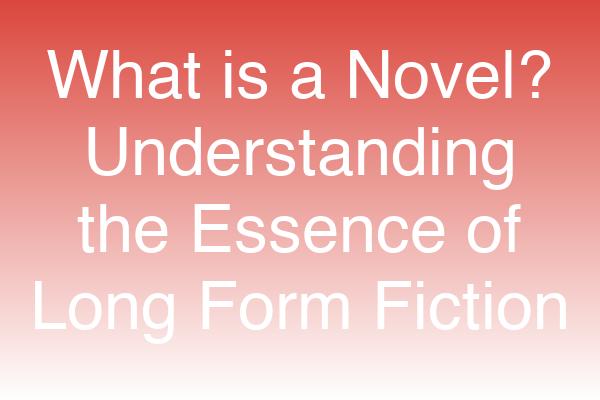
Categories: Literature, Writing, Education
Tags: what is a novel, types of novels, novel structure, literary genres, fiction writing, storytelling
Introduction
Have you ever found yourself lost in the pages of a book, captivated by the characters and their journeys? If so, you’ve experienced the magic of a novel. But what exactly is a novel? In this comprehensive guide, we will explore the definition of a novel, its various forms, structural elements, and its significance in the literary world. Whether you're an aspiring writer or a curious reader, understanding what a novel is can deepen your appreciation for this timeless art form.
What is a Novel?
A novel is a long-form narrative work of fiction that typically explores human experiences through interconnected characters and events. Unlike short stories, which often focus on a single incident or character, novels provide a more expansive canvas for storytelling, allowing for intricate plots and character development.
Key Characteristics of a Novel
- Length: Novels usually exceed 40,000 words, with many ranging between 70,000 to 100,000 words or more.
- Complexity: They often feature multiple characters, subplots, and themes, providing depth and richness to the narrative.
- Character Development: Novels allow for in-depth exploration of characters' thoughts, motivations, and growth throughout the story.
- Narrative Structure: Most novels follow a structured format, including exposition, rising action, climax, falling action, and resolution.
Types of Novels
Novels can be categorized into various genres, each with its unique characteristics. Here’s a table summarizing some popular types of novels:
| Type of Novel | Description |
|---|---|
| Literary Fiction | Focuses on character development and thematic depth over plot. |
| Mystery/Thriller | Involves suspenseful plots, often centered around a crime or puzzle to solve. |
| Romance | Centers on romantic relationships and emotional conflicts. |
| Science Fiction | Explores futuristic concepts, technology, and alternate realities. |
| Fantasy | Features magical elements and imaginary worlds. |
| Historical Fiction | Set in a specific historical period, blending factual events with fictional narratives. |
The Structure of a Novel
Understanding the structure of a novel is crucial for both readers and writers. Most novels follow a traditional narrative arc, which can be broken down into the following components:
- Exposition: Introduces characters, setting, and the initial situation.
- Rising Action: Develops the conflict and builds tension through a series of events.
- Climax: The turning point of the story where the main conflict reaches its peak.
- Falling Action: Events that follow the climax, leading towards resolution.
- Resolution: The conclusion of the story where conflicts are resolved.
The Importance of Novels in Literature
Novels play a vital role in literature and culture. They not only entertain but also provoke thought, challenge societal norms, and provide insights into the human condition. Here are two expert quotes that highlight the significance of novels:
- "A novel is a mirror walking down a road." – Franz Kafka
- "Novels are the most effective way of teaching empathy." – Chimamanda Ngozi Adichie
Common Questions About Novels
What is the difference between a novel and a novella?
A novella is a shorter form of fiction, typically between 20,000 and 40,000 words, focusing on a single theme or character, while a novel is longer and more complex.
Can a novel be non-fiction?
While the term "novel" typically refers to fiction, there are creative non-fiction works that employ novelistic techniques, such as narrative structure and character development.
How do I start writing a novel?
Begin by outlining your ideas, developing your characters, and establishing a plot. Set a writing schedule and commit to regular practice.
Visual Content Suggestions
- Infographic: Create an infographic illustrating the structure of a novel, highlighting key components and their functions.
- Character Development Chart: A visual representation of character arcs in a popular novel, showing how they evolve throughout the story.
Conclusion
In conclusion, understanding what a novel is enriches our reading experience and enhances our writing skills. Novels are not just stories; they are reflections of life, culture, and human emotions. Whether you’re delving into a gripping thriller or a heartfelt romance, the world of novels offers endless possibilities for exploration and connection.
Call-to-Action
Ready to dive deeper into the world of novels? Start your reading journey today by exploring our curated list of must-read novels across various genres!
Social Media Snippet: What is a novel? Discover the essence of long-form fiction, its structure, types, and significance in literature. Dive into the world of storytelling! #WhatIsANovel #Literature
Suggested Internal Links:
- The Art of Storytelling: Techniques for Writers
- Top 10 Must-Read Novels of All Time
- Understanding Literary Genres: A Comprehensive Guide
Suggested External Links:
FAQs
Q1: What defines a novel?
A novel is a long narrative work of fiction that explores complex characters and themes, typically exceeding 40,000 words.
Q2: Are all novels fiction?
Yes, novels are primarily works of fiction, though some creative non-fiction can adopt novelistic techniques.
Q3: How long does it take to write a novel?
The time varies greatly depending on the writer's process, but it can take anywhere from a few months to several years.
Q4: What are some famous novels to read?
Some classics include "Pride and Prejudice" by Jane Austen, "1984" by George Orwell, and "To Kill a Mockingbird" by Harper Lee.
Q5: How can I improve my novel writing skills?
Read widely, write regularly, seek feedback, and study the craft of writing through books and workshops.
This blog post provides a comprehensive overview of what a novel is, its structure, types, and significance, while being optimized for SEO and reader engagement.